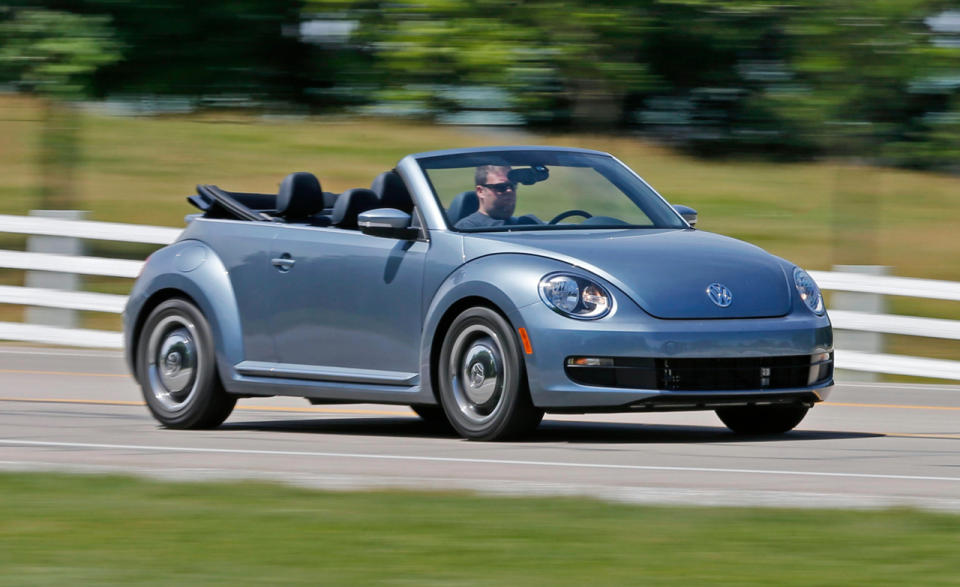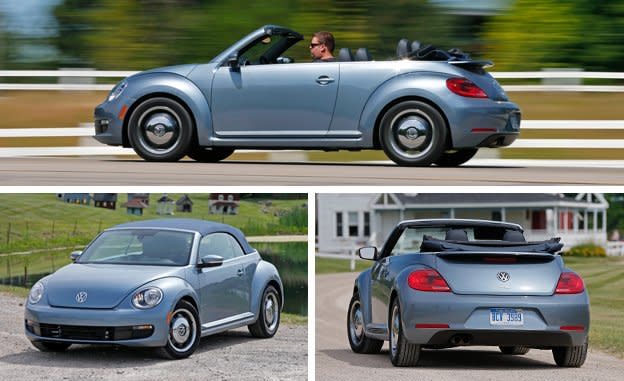2016 Volkswagen Beetle Convertible 1.8T Denim Edition

“If you remember the ’60s, you weren’t really there.” That quote is attributed to a lot of folks who definitely were there, including rockers and acid-heads Grace Slick, Pete Townshend, Wavy Gravy, and Timothy Leary, but the earliest citation extant—1982—credits comedian Charles Fleischer. Conversely, those of us who remember the actual ’70s don’t need That ’70s Show reminding us of what we only wish could be forgotten, such as Whip Inflation Now buttons, lining up to buy gasoline, or watching yet another rerun of Gilligan’s Island because, no, James Hunt was not racing Niki Lauda live on cable.
Issues of memory and the nostalgic impulse not aligning with historic reality certainly apply to this car: the latest special edition of the Volkswagen Beetle, a convertible package dubbed the Denim. Where the Beetle Dune strives to evoke the 1960s without the drugs, the Denim supposedly echoes the Jeans edition Type 1 Beetles of the mid-1970s. Anyone who imagines that these 2016 special editions genuinely revive the cars we drove back then is engaged in an exercise of selective memory, if not suffering hallucinations.
Based on the previous, sixth-generation Golf’s front-drive platform with a turbocharged, water-cooled, four-cylinder mounted transversely in front, rather than the Type 1’s air-cooled flat-four mounted at the rear, the 2016 Beetle Denim is a much better car than anything built in 1975—when, we’ll remind you, everyone thought convertibles were doomed to imminent extinction. The most ’70s thing about this modern Bug is the “jeans-inspired” material used for the folding top and the interior upholstery. It vaguely resembles a pair of genuine denim trousers in the same way that the double-knit leisure suits worn by ’70s country-music stars making guest appearances on Hee-Haw were “jeans-inspired.”
But let us not be purists about our Beetles or 501s. (Levi’s, unlike Beetles, are not better today—trust us.) The material suggests denim clothing, at least, and the coloration and contrast stitching look handsome against the Stonewashed Blue paint of our test car. Like other Beetle convertible tops, this blue-jeansy one is a thick, triple-layer design with a glass window. It does a great job of insulating against noise and weather, folds with the touch of a button at speeds up to 31 mph, and doesn’t impose any severe visibility problems whether up or down. The Denim edition includes 17-inch aluminum wheels in the retro-looking Heritage Graphite design, a blue and silver dashpad, and manually adjustable sport seats that have denim-look centers, white stitching, and little red tags on the seat pockets emblazoned with Beetle logos. Visually, it’s handsome and somewhat more masculine than the ladybug dots and daisy decals that often emblazoned 1970s Beetles.

And, unlike most special-edition packages, this one is a genuine value proposition despite being produced in a “collectible” short run of only 2000 units, equally divided between this color and white. This car listed for $26,815 without the single option offered from the factory: a $500 wind blocker that we’ve previously found to work well enough but happily lived without, given the fuss of installing it and having it block the back seat. That bottom line is only $505 higher than the lowliest of base Beetle convertibles, which is what the car is, aside from the Denim-package appearance items. If you want this look, however, you’ll not be able to get stand-alone options including navigation or HID headlights as you can in the non-Denim car. Still, the Denim is no old-school stripper with rubber mats, hand-crank windows, and manual locks. There’s standard air conditioning; heated, power-folding exterior mirrors; heated washer nozzles; heated seats; a nice leather-wrapped steering wheel with multifunction controls; and even reading lamps. The little whale-tail spoiler is standard on convertibles, mostly because the folded top looks better with it than without it.
Turbocharged, Whale-Tailed, but Not Fast
Special edition aside, this is our first test of any Beetle convertible with the 1.8-liter turbocharged four that replaced a naturally aspirated 2.5-liter five-cylinder as the base engine two years ago. (This generation of the Beetle convertible first arrived for 2013.) The Denim comes solely with the 1.8T, producing 170 horsepower and a stout 184 lb-ft of torque at only 1500 rpm. A six-speed automatic is the lone transmission choice. We’ve twice tested the droptop with the 2.0-liter turbocharged four-cylinder, offered with a choice of manual or dual-clutch automatic six-speed gearboxes in the model formerly known as the Beetle Turbo and now called R-Line. That version also won a two-car comparison test against the Mini Cooper S.
At the track, the Denim 1.8T ran to 60 mph in 7.6 seconds, or 0.2 second slower than the hardtop 2016 Beetle Dune with this same powertrain. That’s 1.3 seconds quicker than the former diesel model but 0.9 second slower than the R-Line and 1.4 seconds behind the Cooper S convertible. The latter two performance-oriented test cars in current form both cost more than $30,000, though. The non-S Mini Cooper convertible—with a nearly identical base price (just $15 lower) to our tested model squeezes only 134 horsepower from its 1.5-liter turbocharged three-cylinder. It does offer a manual transmission, which you can’t get in a Beetle 1.8T, Denim or otherwise, as well as a much longer options list.
Getting to 60 mph in 7.6 seconds is more than sufficient for this car’s top-down cruising personality, and there’s plenty of poke for daily driving, with strong 30-to-50-mph acceleration for urban traffic. The transmission can be lazy about shifting, but Sport mode lets the driver take control when necessary. The independent rear suspension aids the ride over rough pavement. The Beetle Denim exhibited less chassis flex and cowl shake over railroad crossings and pockmarked asphalt than did the Mini convertibles we’ve driven recently, and the ride was comfortable.

It’s not nimble or quick on its feet; both the steering and handling feel heavy and rather like what it is—a standard car (Golf) with a body designed more for stylish looks than efficiencies in packaging, aerodynamics, or structure. At 3216 pounds, this test car weighed just 10 pounds more than the previous-generation convertible did 12 years ago and 89 more than the current R-Line coupe. It circled our skidpad at a respectable 0.84 g, which is strong enough that you needn’t fear off-ramps. Stopping from 70 mph in 176 feet is similarly within the safe zone but not an advantage over competitors.
At seven cubic feet with the top up or down, the trunk is hardly spacious but ample enough to be useful and requires less sacrifice than does the Mini with its top folded. Consider that our long-term Golf with this same drivetrain in the generation-newer chassis weighs less, corners harder, brakes shorter, has a roomier cabin, carries far more stuff, and has more equipment. It’s a much better car for about 10 percent more money than the Denim convertible. But its top doesn’t go down, and no one ever looked over at our Golf at the gas station and said, “cute car,” as happened several times with the Denim. VW in its mysterious wisdom chose not to bring the previous Golf cabriolet sold in Europe to the U.S., but we’re told that’s going to change when a new model arrives soon, so those who don’t need so much retro in their softtop will have another choice.
Speaking of retro, there’s still a CD player in this Beetle, and VW also finally got around to putting a USB port beside the AUX input. So put the top down and find some way to convert your ’70s mix tape into a modern playlist. Don’t leave out Captain Beefheart (“Blue Jeans and Moonbeams”) and Neil Diamond (“Forever in Blue Jeans”), and have a great summer at the beach. We’ll be the ones bringing the picnic goods, though . . . we have a Golf.
Specifications >
VEHICLE TYPE: front-engine, front-wheel-drive, 4-passenger, 2-door convertible
PRICE AS TESTED: $26,815 (base price: $26,310)
ENGINE TYPE: turbocharged and intercooled DOHC 16-valve inline-4, iron block and aluminum head, direct fuel injection
Displacement: 110 cu in, 1798 cc
Power: 170 hp @ 4800 rpm
Torque: 184 lb-ft @ 1500 rpm
TRANSMISSION: 6-speed automatic with manual shifting mode
DIMENSIONS:
Wheelbase: 100.0 in
Length: 168.4 in
Width: 71.2 in Height: 58.0 in
Passenger volume: 81 cu ft
Cargo volume: 7 cu ft
Curb weight: 3216 lb
C/D TEST RESULTS:
Zero to 60 mph: 7.6 sec
Zero to 100 mph: 21.0 sec
Zero to 110 mph: 27.4 sec
Rolling start, 5–60 mph: 8.5 sec
Top gear, 30–50 mph: 3.9 sec
Top gear, 50–70 mph: 5.6 sec
Standing ¼-mile: 15.8 sec @ 89 mph
Top speed (governor limited, C/D est): 120 mph
Braking, 70–0 mph: 176 ft
Roadholding, 300-ft-dia skidpad*: 0.84 g
FUEL ECONOMY:
EPA city/highway driving: 25/34 mpg
C/D observed: 26 mpg
*Stability-control-inhibited

 Yahoo Autos
Yahoo Autos 